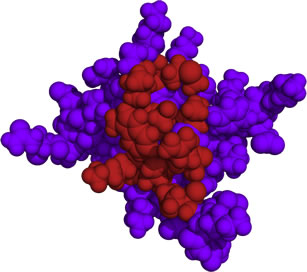Diagnostic assay performance and practicality can be enhanced by engineering both the binding molecules and the reactions used to identify molecular binding events. Engineering protein scaffolds can improve design flexibility and thermostability for specific and sensitive detection of disease biomarkers. Polymerization-based signal amplification can enhance user-friendliness and cost-effectiveness of assay colorimetric readouts.
Biomolecular engineering for affordable medical diagnostics
Immunochromatographic rapid diagnostic tests (RDTs) are an essential tool for the low-cost diagnosis of infectious diseases at the point-of-care. These assays typically employ antibodies as binding proteins to capture disease-relevant biomarkers from patient samples, as well as to associate a visible diagnostic signal with this binding event. However, antibodies are prone to thermal denaturation and nonspecific binding events that can render test results unreliable, and their development is costly and time-intensive, increasing costs to the end user. In order to address these technological gaps, we are developing robust, minimalist affinity reagents based on thermostable protein scaffolds, using yeast surface display and flow cytometric analysis. Guided by chemical engineering principles and numerical modeling approaches, we are also developing methods to enhance intrinsic assay sensitivity and ease-of-use, incorporating these minimalist binders into novel fusion constructs to tailor molecular properties such as binding affinity, immobilized density, and surface valency.
Polymer reaction engineering for affordable medical diagnostics
In addition to developing affinity agents better-suited for application in challenging environments, our group is seeking to further improve upon the RDT format by developing a new method of signal amplification for the transduction of positive binding events. Traditional colorimetric signal amplification methods such as enzymatic dye development or nanoparticle concentration are slow, they tend to produce low-contrast results, and they can produce false negative or false positive results if interpreted outside of the ideal time window for test development. In order to improve upon these techniques, our group has developed a novel means of signal read-out, termed photopolymerization-based amplification (PBA). This method, which uses a macrophotoinitiator conjugated to an affinity agent in the place of the dye-cleaving enzyme or gold nanoparticle, gives rise to a polymer film, visible to the unaided eye, upon exposure of a positive test strip to green light. PBA has been shown to yield a high-contrast, rapid, sensitive, and time-decoupled signal read-out, which could further enhance the suitability of RDTs for communities that could benefit. Our design choices made in incorporating PBA into the RDT format are informed by an awareness of the needs of the end-user, as well as a nuanced understanding of the reaction chemistry, developed over the course of studies exploring the capabilities of PBA on numerous surfaces and at varying reaction conditions.
